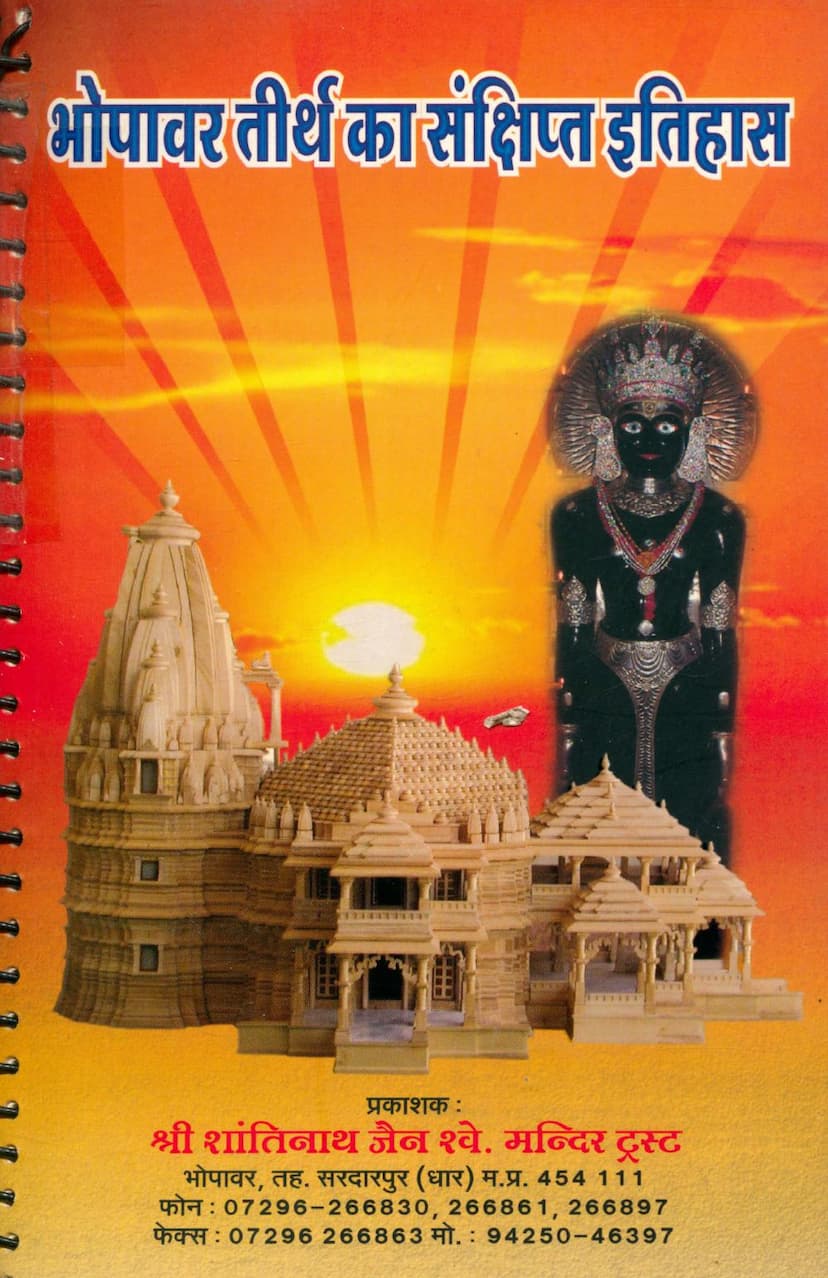Bhopavar Tirth Ka Sankshipta Itihas
Added to library: September 1, 2025
Loading image...

Summary
Here's a comprehensive summary of the Jain text "Bhopawar Tirth ka Sankshipta Itihas" (A Brief History of Bhopawar Tirth) by Yashwant Chauhan, published by Shantinath Jain Shwetambar Mandir Trust:
This book chronicles the history, significance, and development of the Bhopawar Tirth, a prominent Jain pilgrimage site in Madhya Pradesh, India.
Key Highlights and Themes:
- The Unique Idol of Lord Shantinath: The central focus of Bhopawar Tirth is a magnificent, standing idol of Lord Shantinath, the 16th Jain Tirthankar. This idol is carved in the kayotsarg (meditative standing posture) and is approximately 12 feet tall and made of dark stone. It is described as being unique in the world for its kayotsarg posture.
- Ancient Origins: The book strongly emphasizes the antiquity of the Tirth. It is claimed to be around 87,000 years old, dating back to the time of the 22nd Tirthankar, Lord Neminath. This claim is supported by references to Jain scriptures like the Kalpa Sutra, which indicates a significant time gap between Lord Parshvanath and Lord Neminath, and then between Lord Parshvanath and Lord Mahavir. The book notes that the original sanctum sanctorum (Garbha Griha) remains intact, further attesting to its ancient origins.
- Historical Significance:
- Mythological Connection: The establishment of the city of Bhojkot (later known as Bhopawar) is linked to the epic Mahabharata. It is stated that Rukmi, the brother of Lord Krishna's wife Rukmini, founded the city of Bhojkot (also referred to as Bhojkut) after being defeated by Krishna. The text mentions that Krishna, Balarama, Rukmini, and Pradyumna visited this place for the wedding of Aniruddha (Krishna's grandson) with Rochana (Rukmi's granddaughter).
- Indian Independence Movement: The book also touches upon the historical significance of the region during the 1857 Indian independence struggle. It mentions the role of Rana Bakhtawar Singh of Amjhera, who was a key figure in the rebellion against British rule in the Malwa region, and how the events in Amjhera had repercussions in Bhopawar.
- Development and Renovation: The history details the Tirth's journey from its ancient past to its current state. It highlights:
- Past Custodians: The administration of the Tirth has passed through several generations of families.
- Renovation Efforts: The book describes extensive renovation and reconstruction efforts, particularly the construction of a new, grand Jinalaya (temple). It details the foundation laying ceremony, the installation of various significant stones, and the architectural plans for the new temple, which is made of renowned Bansi Pahadpur stones and Makrana marble. The estimated cost for the new temple was around 15 crore rupees.
- Trust Establishment: The establishment of the Shri Shantinath Jain Shwetambar Mandir Trust is mentioned as a crucial step in managing and developing the Tirth.
- Spiritual and Miraculous Events: The text recounts several instances of divine influence and miracles associated with the Tirth and the idol of Lord Shantinath. These include:
- Milk flowing from the sanctum sanctorum.
- A serpent coiling around the idol's feet and respectfully moving away upon request.
- Amrut (nectar) flowing from the idol's head.
- The sound of anklets being heard in the temple.
- The appearance of white serpents, considered auspicious.
- Instances of lost items being found after prayer.
- Key Personalities: The book acknowledges the contributions of various individuals and groups in the development and promotion of the Tirth:
- Author: Yashwant Chauhan ("Rashtriya Oj Kavi").
- Publisher: Shantinath Jain Shwetambar Mandir Trust, Bhopawar.
- Inspirational Figures: Acharya Shri Navratnasagar Surishwarji Maharaj, Ganivarya Shri Vishwaratna Sagarji Maharaj.
- Key Supporters: Shri Ramanbhai Jain (Montex Group) Mumbai, Shri Surendrakumar Rajmalji Jain Dhar.
- Trustees: A list of trustees involved in the management of the Tirth is provided.
- Festivals and Celebrations: The Tirth hosts several significant annual festivals:
- Lord Parshvanath's Birth Anniversary (Janma Kalyanak Utsav): Celebrated on Poush Vadi Dashami, it involves a three-day festival with pujas, processions, and devotional activities.
- Tribal Festival: Celebrated on the day after Holi, where tribal communities visit and offer their devotion.
- Lord Shantinath's Birth and Nirvana Anniversary: Celebrated on Jyeshth Vadi 13.
- Facilities for Pilgrims: The Tirth offers various facilities for visitors, including:
- A large, well-equipped Dharamshala with 20 rooms and two large halls for groups.
- An Upashray (residence for monks and nuns).
- A modern, well-equipped dining hall that can seat 500 people, with arrangements for Ayambil (a specific type of fasting).
- Plans for a new 200-room Dharamshala are mentioned.
- Geographical Location and Accessibility:
- Bhopawar is situated in the Dhar district of Madhya Pradesh, about 46 km from the district headquarters and 8 km from Sardarpur tehsil.
- It is located on the Indore-Ahmedabad National Highway, making it accessible.
- New roads have been constructed to improve connectivity from Dhar and Indore.
- The Tirth is near the Mahi River.
- Interestingly, the text notes that despite being a significant Jain Tirth, there are no Jain families residing in the immediate village of Bhopawar.
- Future Plans: The book outlines ambitious future plans for the Tirth's development, including the construction of a larger hall for lectures, a new 200-room Dharamshala, an old age home, a boarding school, a free hospital for tribals, a museum for ancient idols, a study center for monks, a new bus stand, and a cowshed.
- Nearby Tirths: The book also provides details of other important Jain pilgrimage sites located in the vicinity, such as Mohan Kheda, Amijhara Parshvanath, Bhaktamar Tirth (Dhar), Mandavgarh, etc.
In essence, "Bhopawar Tirth ka Sankshipta Itihas" serves as a comprehensive guide to this ancient and spiritually significant Jain pilgrimage, highlighting its unique idol, deep historical roots, continuous development, and the profound faith it inspires.